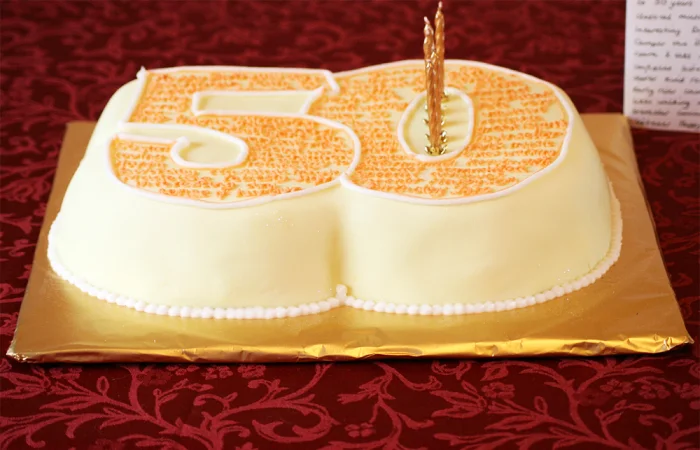Table of Contents
Birthday cake
A 50th birthday cake idea is a bar eaten as part of a party. Birthday cakes are regularly layered desserts with frosting served with small lit candles on a pinnacle representing the celebrant’s age. Variations encompass cupcakes, cake pops, pastries, and cakes. The cake is frequently decorated with birthday desires (“Happy birthday”) and the celebrant’s call.
Birthday desserts have been part of birthday celebrations in Western European nations since the center of the 19th century. However, the link between cakes & birthday celebrations may date lower back to ancient Roman instances.
In the classical Roman lifestyle, ‘cakes’ were once in a while served at unique birthdays and at weddings. These were flat circles crafted from flour and nuts, leavened with yeast, and sweetened with honey.
In the fifteenth century, bakeries in Germany began to market one-layer cakes for customers’ birthdays further to cakes for weddings. During the 17th century, the birthdate cake took on its current form.
These difficult 17th-century cakes had many components of the present-day 50th birthday cake ideas, like more than one layer, icing, and decorations. However, these desserts have been best to be had by the very wealthy. Birthday cakes became reachable due to the decreased magnificence of the commercial revolution and the unfolding of greater substances and goods. So, it has grown to be the culture and tradition to have fun the birthday with delicious cake and beautiful desires
Contemporary rites
The cake, pastry, or sweet is served to someone on their birthday. In modern Western cultures, the cake is topped with one or more lit candles, which the prestigious character tries to blow out.
There are not any well-known birthday cakes, even though the “Happy Birthday” track is often sung at the same time as the cake is served in English-speaking countries or an equivalent birthday song in the correct language of the United States. The phrase “satisfied birthday” did no longer appear on birthday cakes until the music “50th birthday cake ideas ” became popularized within the early 1900s.
Differences in birthday songs and rituals exist in unique parts of the world. In Uruguay, party visitors contact the man or woman’s shoulder or head following the making of a song of “Happy Birthday to You”. The person whose anniversary it is will take a massive chunk of the birthday cake earlier than its miles served.
Contemporary Rites 50th birthday cake ideas
In Peru, visitors sing “Happy Birthday to You” first in English with the name of the character whose birthday it’s miles, then in Spanish, later they sing any other music regarding cake or date, ultimately blowing candles and serving the cake.
The birthday cake is frequently embellished with small candles, secured with special holders, or clearly pressed down into the cake. The cake also be served with other candies including ice cream. In the UK, North US, and Australia, the quantity of candles is typically the same as the age of the character whose birthday it’s far away, every so often with one extra for good fortune. Traditionally, the individual whose birthday it’s far away makes a wish, which is a concept to return true if all the candles are extinguished in a single breath.
To represent a distribution of joy and an experience of togetherness, the cake is shared amongst all of the guests attending the celebration.

Candles and theories of foundation
In many cultures, the character whose birthday is being celebrated is invited to make a want and blow out candles. Though the precise beginning and significance of this ritual is unknown, there are more than one theories that attempt to provide an explanation for this subculture.
Greek foundation tale
One principle explaining the culture of putting candles on birthday cakes is attributed to the early Greeks. Who used candles to honor the goddess Artemis’ starting on the 6th day of every lunar month. The link between her oversight of fertility & the birthday tradition of candles on cakes, however, has no longer been established.
Pagan foundation tale
The use of fireplaces in certain rites dates lower back to the creation of altars. Birthday candles are said to keep symbolic electricity.
In the past, it became believed that evil spirits visited human beings on their birthdays, to guard the person whose birthday it was from evil. Human beings should surround the individual and make them merry. Gathering-goers made noise to scare away evil spirits.
Germans beginning story
In 18th century Germany, the records of candles on desserts may be traced back to Kinderfest, a party for youngsters. This subculture also makes use of candles and cakes. German kids have been taken to an auditorium-like area. There, they were unfastened to have a good time for another 12 months in an area where Germans believed that adults included children from the evil spirits trying to steal their souls. In those times there was no way of life of bringing gifts to a birthday. Visitors might simply deliver proper needs for the birthday person. However, if a visitor did deliver items it was taken into consideration to be a very good signal for the individual whose birthday it changed into. Later, flowers became quite popular as a birthday present.
In 1746, a huge birthday pageant was held for Count Ludwig von Zinzendorf at Marienborn near Büdingen. Andrew Frey defined the birthday celebration in detail and mentions. “There has been a Cake as massive as any Oven may be determined to bake it, and Holes made inside the Cake in keeping with the Years of the Person’s Age, everyone having a Candle stuck into it, and one inside the Middle.
Beginning story
Johann Wolfgang von Goethe spent 24–30 August 1801 in Gotha as a visitor of Prince August of Saxe-Gotha-Altenburg. Recounts his 52nd birthday on 28 August: “… While it was time for dessert, the prince’s whole livery in complete regalia entered, led via the majordomo.
He carried a beneficial-length torte with colorful flaming candles – amounting to some fifty candles – that started to melt and threatened to burn down. In preference to there being enough room for candles indicating upcoming years. As is the case with children’s festivities of this type.
As the excerpt indicates. The way of life at the time turned into to area one candle on the cake for every 12 months of the man or woman’s life. So that the wide variety of candles on top of the cake could represent the age that someone had reached. Every so often a birthday cake would have a few delivered candles ‘indicating upcoming years.’
Swiss foundation story
A reference to the culture of blowing out the candles was recognized in Switzerland in 1881. Investigators for the Folk-Lore Journal recorded various “superstitions” a number of the Swiss center class. One assertion depicted a birthday cake as having lighted candles that correspond to every 12 months of lifestyles. These candles were obligatory to be blown out, individually, by using the person who is being celebrated.
Birthday desserts in unique cultures 50th birthday cake ideas
There are many variations of goodies which might be eaten round the arena on birthdays. The Chinese birthday pie is the shòu bāo (壽包, simp. 寿包) or shòu táo bāo (壽桃包, simp. 寿桃包), a lotus-paste-crammed bun made from wheat flour and fashioned and colored to resemble a peach. Rather than serving one big pastry, each guest is served their very own small shop bao. In Western Russia, birthday kids are served fruit pies with a birthday greeting imprinted into the crusts.
The Swedish birthday cake is complete like a pound cake that is often crowned with marzipan and decorated with the national flag. Dutch birthday pastries are fruit cakes crowned with whipped cream. In India there are only a few people who rejoice birthdays in the villages, but in towns and cities. Birthday cakes are ate up in addition as in western countries, especially among human beings with higher schooling.


